How Big Sky, Montana, Became One of America's Best Places to Ski — and Why 2024 Is the Year to Go
Generations of skiers have known Big Sky as a low-key ski destination. But with new luxury resorts and tricked-out lifts, word is about to get out.
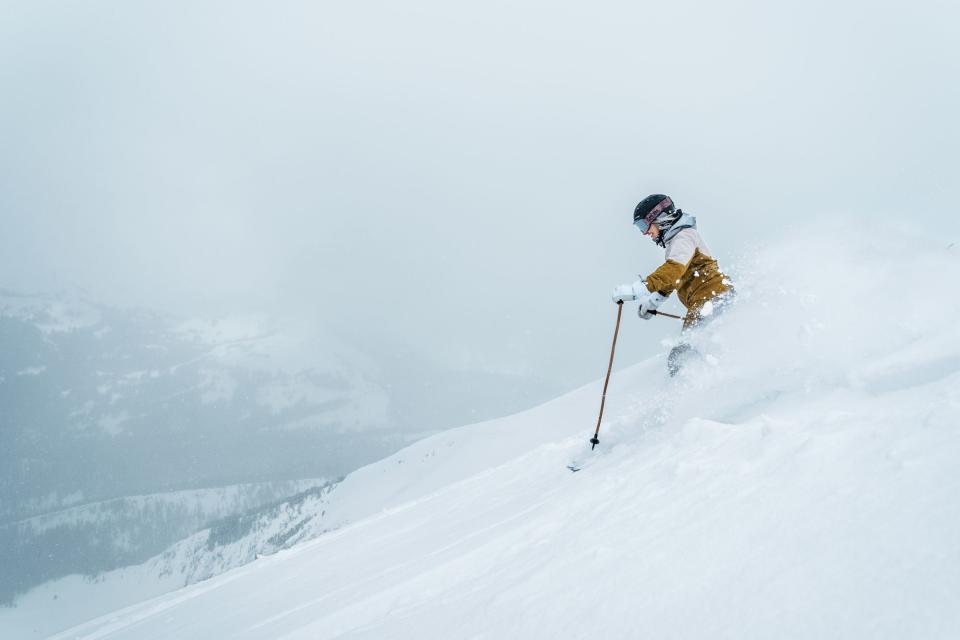
Mark Hartman
Descending the Liberty Bowl at Big Sky Resort, in Montana."You have to go to Big Sky” is a refrain I’ve often heard from fellow skiers. At a time when skiing evokes images of long lift lines and crowded slopes, Big Sky trades on a reputation for solitude and space. Located between the city of Bozeman and Yellowstone National Park, the 5,850-acre Montana resort has an average of one acre for every skier; supposedly, you can ski all day without seeing the same run twice. It’s the third-largest ski resort in North America after Whistler Blackcomb, in British Columbia, and Park City Resort, in Utah.
But diehards know what really puts the big in Big Sky. In skiing parlance, the word describes terrain that is above the tree line, steep, sustained, and exposed — meaning a fall could be long and of high consequence. For a U.S. ski resort, Big Sky has a unique preponderance of this type of advanced terrain. Much of it — including the most famous run, Big Couloir — lies on Lone Peak, a stark and wind-battered summit reached by a single-car tram.
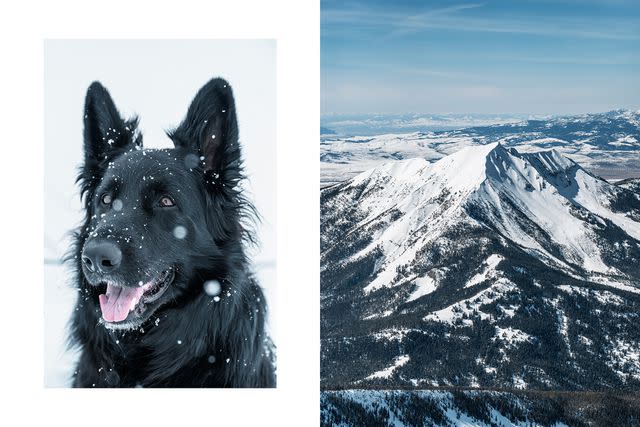
Mark Hartman
Fron left: Tela, a certified avalanche dog; Fan Mountain, as seen from Lone Peak, at Big Sky.I’ve always joked that if I’m not a beautiful skier, I am a brave one. I learned as an adult, mostly by throwing myself at scary slopes and skiing down in survival mode, so I don’t rattle too easily when I’m at a resort. (My fiancé, Dan, and I also ski in the backcountry in California’s Sierra Nevada.) But the week before I leave for Montana, I see a video of a skier on “The Big,” as locals call it. Plunging down the 1,400-foot vertical face between bands of unforgiving rock, the skier looks tiny and inconsequential. Yet he moves with strength and intention, responding to the demands of the terrain. Adding to the sense of seriousness is an article accompanying the video, which informs me that, to ski the Big, one must not only sign out for a time slot with ski patrol but also go with a partner and wear an avalanche beacon. I’ll have those. But will I have the skills?
"Big Sky is in the midst of a transformation. For decades, it was off most people’s radars, being somewhat difficult to get to and offering great skiing but not much else."
Dan and I arrive on a brilliantly sunny March afternoon at the Montage Big Sky, a luxury ski-in, ski-out hotel that opened in December 2021. A glass wall in the lobby reveals a dramatic view of the peaks, which contrast between snow and shadows. At the front desk, a receptionist offers us hot apple cider spiked with rum, and a few minutes later a bellman in a stylish Stio jacket delivers our gear to our room. He asks if we’re skiing today — if so, he’ll leave our gear outside for us. We say no, and he checks his watch. It’s 2:15 p.m. “You should go,” he urges. We demur, citing work commitments, but he’s unimpressed. “It’s so close,” he points out, gesturing at the window. Indeed it is: there’s the lift.
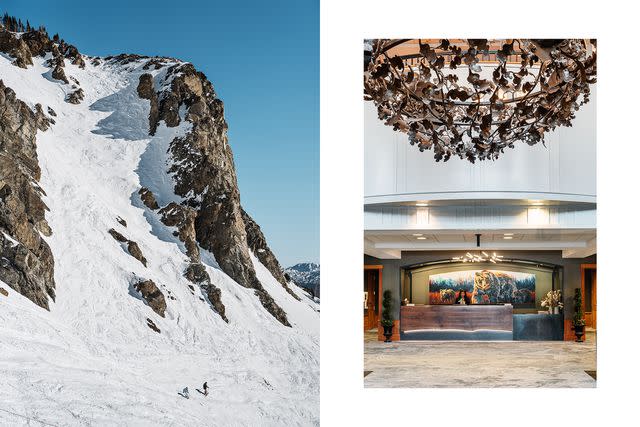
Mark Hartman
From left: Skiing the lower section of Pinnacles, an expert run on Lone Peak; the reception area at the Summit Hotel.Big Sky is in the midst of a transformation. For decades, it was off most people’s radars, being somewhat difficult to get to and offering great skiing but not much else. Over the past 10 years, though, more direct flights to Bozeman have been added, including from New York and San Francisco; the resort has joined the Ikon Pass (which bundles admission to more than 50 ski resorts around the world); and lodging has become increasingly luxe with the revival of the Yellowstone Club (a private residential resort) and the opening of the Montage. A One&Only is also set to arrive in winter 2025 in Moonlight Basin, just north of Big Sky. The town center has grown up, too, into a hip outpost that offers pho and mezcal cocktails.
Related: The 50 Best Places to Travel in 2024
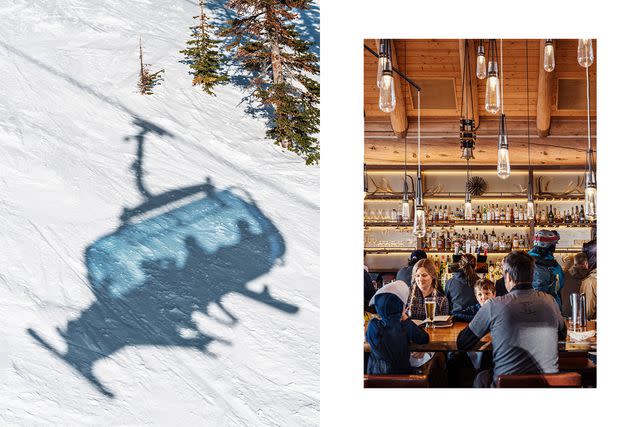
Mark Hartman
From left: The shadow of the Swift Current lift; dinner at Cortina.Not everyone loves the changes. Housing costs have skyrocketed well beyond the reach of many Big Sky workers, and locals worry that the area will lose its character as more wealth floods in. Big Sky still can’t rival the off-mountain glitz of an Aspen or a Jackson, and many residents would like to keep it that way. There’s a down-to-earth vibe, with a healthy mix of families and young people. Even among the well-heeled guests at the Montage, there isn’t a flamboyant fur-trimmed puffer in sight. And anyway, people don’t go to Big Sky to hang out in town: here, it’s still about the skiing. “Big Sky is an adult playground,” says Kara Blodgett, co-owner of the restaurant and bottle shop Rocks Tasting Room & Liquor Store, which deals in Montana-made booze and beer.
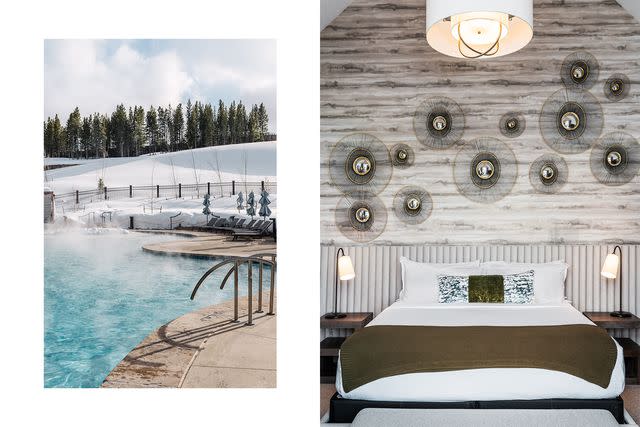
Mark Hartman
From left: The heated pool at the Montage; a guest room at the resort.In that spirit, I could say more about staying at a ski hotel where rooms start at $1,500 a night. Yes, the massage at the spa is sublime, and, yes, I could sip Veuve Clicquot La Grande Dame at the hotel’s après-ski champagne bar. But I’d argue that the greatest luxury the Montage offers is its proximity to the chairlift: Dan and I could walk maybe 30 feet to the snow. The Montage is surrounded by mostly beginner runs. (In fact, at Big Sky, about 2,300 acres, more than the total acreage of many ski areas, is beginner or intermediate level terrain, making it ideal for groups with varying skill levels.) To get to the expert stuff, we meet our guide, Shannon Held, who’s been an instructor at Big Sky for 18 years, and together we head to the main village.
Related: What to Pack for Ski Trip
We load into a high-speed lift with heated leather seats so plush that Dan jokes we’re at an IMAX. Everything at Big Sky feels new, because a lot of it is. The resort is close to wrapping up a massive, decade-long improvement plan called Big Sky 2025 that includes a revamped base area, 11 additional chairlifts, and the new tram for the 2023–24 season. As the chair ascends, we get our first up-close look at the golden cliffs of Lone Peak, a rippling, muscular mountain that looks plucked straight out of the Alps. For the next couple hours, Shannon, who has the ruddy cheeks and undentable cheer of a veteran instructor, takes us through a progression of bump runs on its flanks. She’s sparing with feedback, giving us just small tips: flex our ankles more, and spend a millisecond longer on each turn.
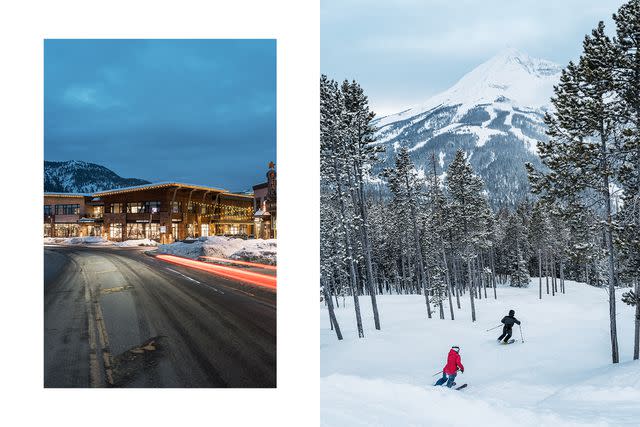
Mark Hartman
From left: Downtown Big Sky; skiers on the Spotted Elk run.After a lunch of grilled cheese and prosciutto sandwiches with truffle fries at Everett’s 8800, one of the resort’s on-mountain restaurants, we go to the Headwaters, another zone with expert-level steep skiing. As we ride the two-person chair to the top, I watch skiers navigate the wind-buffed slope, breaking off chunks of snow that cascade down the mountain and tinkle like bells. Suddenly, an odd movement catches my eye. A teenage-looking skier, dressed in black, is sliding headfirst beneath us. From the chair ahead, Shannon and another skier shout at him to get his skis below him to stop his fall, but as he bounces over a bump, one ski breaks loose, then another. He’s well over halfway down and still sliding fast.
Up to this moment, I hadn’t thought about how sheer this slope is, but now I’m spooked. We’re about to ski Cold Spring, a trail often used as a test run for the Big Couloir. I do a quick head check — I used to race mountain bikes, and sometimes, before riding scary sections, I would remind myself of similar trails I’d conquered before. I called it my mental Rolodex of experience. I don’t have a deep Rolodex for skiing, but thanks to racing, I do have one for overcoming nerves, so I know I need to take a breath, push the image of the sliding kid out of my head, and focus on executing good technique. It works: as I start down, I feel surprisingly in control. When I reach the bottom, Shannon smiles and tells me, “Good skiing.”
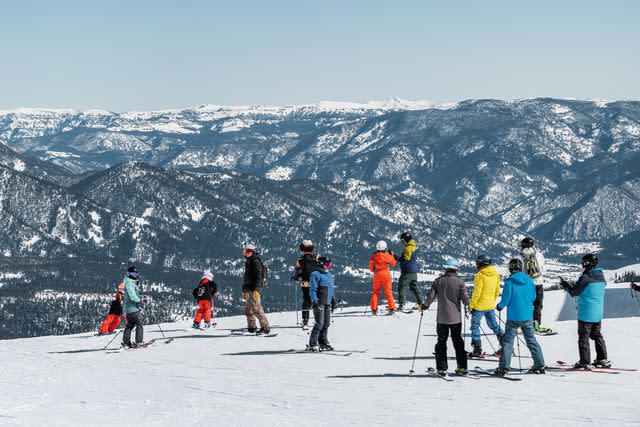
Mark Hartman
The view from the top of the Swift Current lift.Throughout the day, we intersperse challenging runs with wide-open groomed trails and playful routes between the trees. Usually I jump into tricky terrain before I can overthink it, but with Shannon guiding, we pause at the top of each steep run to discuss lines and snow conditions. This is a new, and more disciplined, approach, and it forces me to focus and move with intention. In time I find it more rewarding — nailing each descent feels like hitting a carefully targeted bull’s-eye. Shannon’s tips prove to be revelatory on steep bumps, too. The motion feels easier, less boxing match and more waltz, so light on my feet I barely recognize my shadow.
More Trip Ideas: The Best Times to Visit Glacier National Park
That night, after a full day of skiing, we’re trundled up the mountain by snowcat to the Montana Dinner Yurt, where a guitarist wearing a trucker hat plays in a corner and flannel-clad servers welcome us with French onion soup, pink filet mignon, and Toblerone fondue for dessert. When we return to our room at the Montage, both the fireplace and a humidifier (a thoughtful touch) are running.
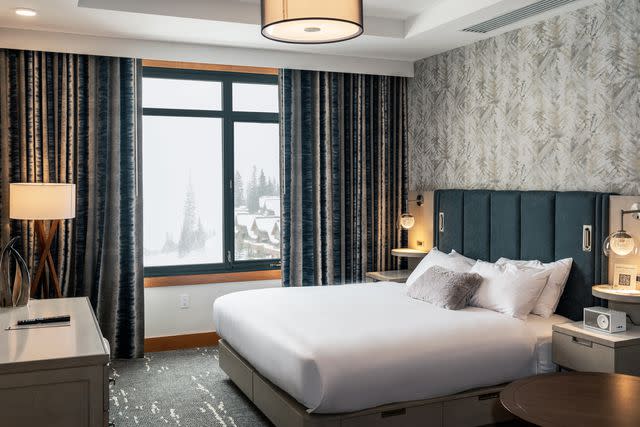
Mark Hartman
A guest room at the Summit Hotel.A bit of lore: in 1976, Big Sky, which had operated for just three years as a small resort, was purchased by Everett Kircher, the founder of a portfolio of ski areas called Boyne Resorts. Kircher installed his son John as general manager. The younger Kircher dreamed of building a lift on Lone Peak. Many told him it would be too complex, and Dad wouldn’t approve it. But Dad was based in Michigan, so one day John just — oops — ordered a tram.
Related: 14 Best Things to Do in Montana Year-round
Unlike a gondola, which has multiple cabins that go up and down the mountain continuously in a loop, aerial trams have just one or two larger cabins that shuttle back and forth. The original tram that John installed was already a feat of lift engineering. But when it opens for the 2023–24 winter season, the new Lone Peak tram will be both faster and larger, traveling 600 more feet in roughly the same amount of time while increasing capacity from 15 to 75 passengers per cabin.

Mark Hartman
Dessert at Cortina, a northern Italian restaurant at Montage Big Sky.It will also feature large glass side panels and a glass floor. To me, the old tram is knee-weakening enough already. As we ascend, the mountain face is sometimes just a few feet outside the window. A woman, spying a set of ski tracks, remarks, “That seems dangerous”; and an instructor quips, “Everything up here is dangerous.”
At the start of the day, Shannon declared we would be skiing the Big, but on a test run on Gully 1 — which has a nearly identical orientation — we find snow the consistency of Styrofoam. Not ideal. In hopes of finding better conditions, we decide to pivot to the North Summit Snowfield, another triple-black diamond that drops precipitously over a cliff band.
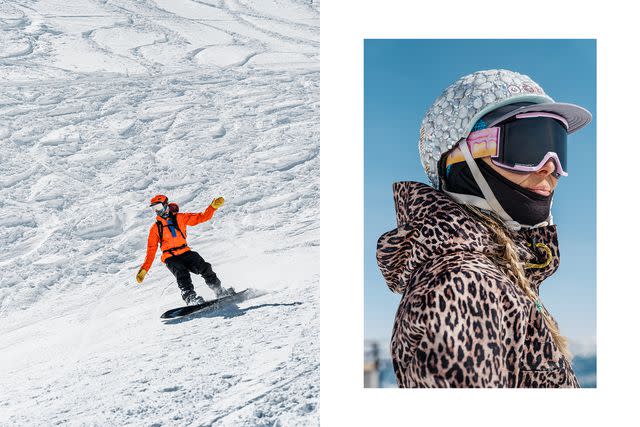
Mark Hartman
From left: Snowboarding down the Gullies, a series of six double-black-diamond runs at Big Sky; skier Hailey Rumore.At the top, we walk into a wooden shack where a patroller is assigning time slots. Like the Big Couloir, the North Summit Snowfield requires guests to ski with a partner, wear an avalanche beacon, and sign out with ski patrol. That last step controls the number of people on the slope and also allows staff to conduct a frank conversation. The patroller informs us that the traverse to the starting point is all hard ice — “bulletproof,” he calls it — and encourages us to refresh ourselves on our self-arresting skills. As we click in to our skis, I try to tamp down my apprehension.
"The motion feels easier, less boxing match and more waltz, so light on my feet I barely recognize my shadow."
The traverse is as advertised; while I’m waiting for my turn, a skier loses his purchase and blows past Dan. It rattles me. I dig my edges into the slope for reassurance. When it’s my turn, I refer to the Rolodex (which has a few new cards from yesterday), take a deep breath, and drop in. The skiing is intimidating, each turn demanding a renewed commitment. I turn and turn, hitting hard and chattery snow on the left, in the sun, and soft powder on the right, in the shade. All day, I’ve been watching how Shannon cuts wide, rounded, identical turns, like she’s drawing an electrical coil down the mountain. Textbook. I try to emulate her and focus on good form. About two-thirds of the way down, my legs are beginning to burn, but I keep moving.
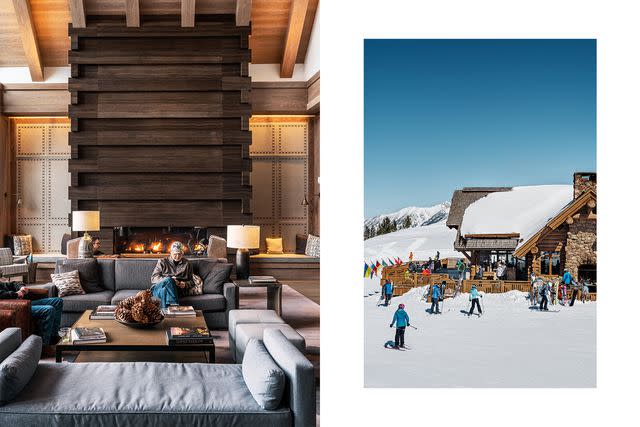
Mark Hartman
From left: Cozying up in the Montage Big Sky lounge; Everett's 8800, a restaurant at the top of Andesite Mountain.Dan and Shannon watch from the bottom, and when I reach them, I feel a burst of pride. We hoot and tap our poles, and suddenly, more seems possible. This is the appeal of steep skiing. “As you change how you see the hill,” Dan Egan, an extreme-skiing pioneer who runs clinics at Big Sky, tells me later, “it will change the way you see your life.”
We spend the last two nights of our trip in the main village, at the recently renovated Summit Hotel, which has a homey atmosphere — the bellmen wear cowboy hats, and milk and cookies are served in the lobby. Our room is so close to the eight-person Ramcharger chairlift that we can hear the snow groomers beeping at night. On our final morning, we take advantage of the resort’s early access add-on, which allows skiers onto the lift at 8 a.m. instead of 9, to squeeze in some extra runs before our shuttle to the airport.

Mark Hartman
A view of Lone Peak from Everett's 8800 restaurant.Being at a resort before it opens is a quiet, intimate experience: hearing the hum of cables, watching the mountain wake up. While we had slept, a small storm had blown through, and now we savor a light blanket of powder. A few runs in, we share a chair with a gray-haired man who’s been skiing Big Sky for 17 years. His life’s ambition was to be a ski bum, but he ended up becoming a lawyer instead. “Skiing is the most decadent thing you can do on the planet,” he says. “Think of all the material science, the technology, the equipment it takes to get you to the top of the mountain, just so you can slide back down and go, WHEE!”
Dan eventually goes back to the hotel room, and I stay out on my own. I find an untouched stretch and paint a long, swishy brushstroke down. By my last run the sun is high, and the snow sparkles in the air like I’m moving through a glitter bomb. Skiing can be a way to push your limits, or it can be the most indulgent thing you do. On the best trips, on the best mountains, it’s both.
Where to Stay
Montage Big Sky: This 139-room resort — which can arrange year-round tours of nearby Yellowstone National Park — is the epitome of Western luxury.
The Summit Hotel: At the foot of Lone Peak, this sleek slopeside hotel puts you in the center of the action.
Where to Eat
Everett’s 8800: Refuel after a morning of skiing at this mountaintop gastropub.
Montana Dinner Yurt: Backcountry dining at its most indulgent, with a side of candlelight and live music.
The Rocks Tasting Room & Liquor Store: Head into town for bison-and-mushroom flatbread or a bowl of pho, plus Montana-made spirits.
What to Do
Big Sky Mountain Sports School: Explore the resort’s most challenging terrain with a private guide.
A version of this story first appeared in the December 2023/January 2024 issue of Travel + Leisure under the headline "Go Big or Go Home."
For more Travel & Leisure news, make sure to sign up for our newsletter!
Read the original article on Travel & Leisure.

